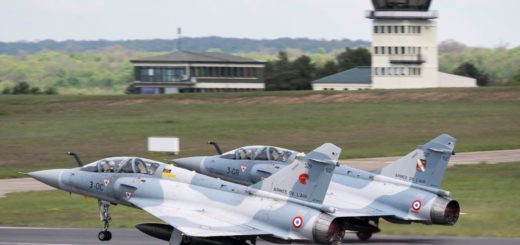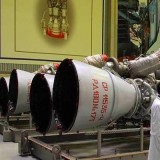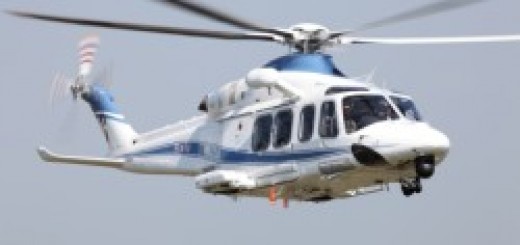US Air Force invests $600 million to accelerate the production of key long-range precision strike missiles
{loadposition bannertop}
{loadposition sidebarpub}
As reported by Colby Badhwar on March 31, 2025, the U.S. Air Force recently raised the ceiling of its current indefinite-delivery, indefinite-quantity (IDIQ) contract with Lockheed Martin for the Joint Air-to-Surface Standoff Missile (JASSM) and Long Range Anti-Ship Missile (LRASM) programs. The ceiling increase, from $450 million to $600 million, covers full life-cycle support for all existing and future variants of both missile types. This contract modification applies through June 2027, with a follow-on five-year IDIQ expected in June 2025 to cover activities through 2032.Follow Army Recognition on Google News at this link
The Long Range Anti-Ship Missile (LRASM), as well as the Joint Air-to-Surface Standoff Missile (JASSM), represent key components of the U.S. military’s long-range precision strike inventory. (Picture source: Lockheed Martin)
The Joint Air-to-Surface Standoff Missile (JASSM) and the Long Range Anti-Ship Missile (LRASM) represent key components of the U.S. military’s long-range precision strike inventory. Developed by Lockheed Martin, both missile types share a common airframe and propulsion system but are optimized for different mission profiles. In March 2025, the U.S. Air Force awarded a $1.93 billion contract modification to Lockheed Martin for additional production of JASSM and LRASM, bringing the total contract value to $5.18 billion. The AGM-158 family enables air-launched strikes against fixed, relocatable, or maritime targets from standoff distances, supporting operations against advanced air defense systems.
JASSM variants include the AGM-158A baseline model, with a range exceeding 370 km, and the AGM-158B Extended Range (JASSM-ER), capable of reaching beyond 925 km. Both models carry a 450 kg WDU-42/B penetrating warhead and use a combination of inertial navigation, GPS, and imaging infrared guidance. Advanced variants under development include the AGM-158B-2 with updated electronics and anti-jam GPS; the AGM-158B-3 with M-code GPS for improved jam resistance; and the AGM-158D with a weapon data link for in-flight retargeting and aerodynamic improvements. The JASSM-XR (Extreme Range), first revealed in 2024, extends the potential strike range to 1,600–1,800 km using a lengthened airframe and additional fuel, while retaining the standard warhead.
JASSM development began in 1995 after the cancellation of the TSSAM program. Lockheed Martin was selected in 1998 to proceed with development, and the missile achieved initial operational capability in 2003, followed by full qualification in 2009. JASSM-ER development followed in the mid-2000s, with first operational deliveries in 2014 and full-rate production starting in December 2014. Since 2017, all production has focused on JASSM-ER and its variants. The missile has been integrated on multiple platforms, including the B-1B, B-2, B-52H, F-16C/D, and F-15E, and is planned for integration in the F-35 Block 4 upgrades. JASSM has been exported to Australia, Finland, Poland, and the Netherlands, with operational integration on F/A-18 and F-16 aircraft.
Operational use of JASSM includes a 2018 U.S. strike on Syrian chemical weapon sites and a 2019 strike against ISIS leadership. The missile has replaced the retired AGM-86C/D CALCM as the U.S. Air Force’s standard air-launched conventional cruise missile. Production has scaled accordingly, with Lockheed Martin producing over 500 JASSM/LRASM missiles per year by 2023 and planning to increase output to 1,000 per year. The U.S. Air Force has outlined a goal of acquiring approximately 10,000 missiles in total. Allied operators use the missile to enhance strike capability at extended ranges, with Australia, Poland, and Finland among the early adopters.
The LRASM (AGM-158C), derived from JASSM-ER, incorporates additional sensors and autonomy features for maritime targeting. It uses a combination of infrared and passive RF sensors to identify and engage surface ships with minimal external guidance. LRASM’s range is officially over 370 km, with classified estimates exceeding 500 km. It carries the same 450 kg warhead as the JASSM and is equipped with a two-way data link for in-flight coordination. LRASM’s autonomous functions allow it to operate in contested electromagnetic environments and coordinate with other missiles during a salvo for distributed targeting. An extended-range version, designated AGM-158C-3, is in development, along with ongoing seeker and software improvements.
LRASM development began in 2009 under DARPA’s Offensive Anti-Surface Warfare initiative. The subsonic variant became the program of record after the supersonic version was canceled. Initial testing on the B-1B and F/A-18E/F began between 2013 and 2017, followed by production and fielding. The missile reached IOC with the B-1B in 2018 and with the Super Hornet in 2019. It is also being integrated into the F-15E, F-15EX, F-16C/D, P-8A Poseidon, and F-35 variants. Australia has acquired 200 LRASM missiles for use on the F/A-18F and future F-35A aircraft. The missile is not currently planned for surface or submarine launch, as the U.S. Navy is pursuing a separate hypersonic anti-ship missile (HALO) for that role. LRASM is managed as a joint U.S. Air Force and U.S. Navy program with potential allied participation.

{loadposition bannertop}
{loadposition sidebarpub}
As reported by Colby Badhwar on March 31, 2025, the U.S. Air Force recently raised the ceiling of its current indefinite-delivery, indefinite-quantity (IDIQ) contract with Lockheed Martin for the Joint Air-to-Surface Standoff Missile (JASSM) and Long Range Anti-Ship Missile (LRASM) programs. The ceiling increase, from $450 million to $600 million, covers full life-cycle support for all existing and future variants of both missile types. This contract modification applies through June 2027, with a follow-on five-year IDIQ expected in June 2025 to cover activities through 2032.
Follow Army Recognition on Google News at this link
The Long Range Anti-Ship Missile (LRASM), as well as the Joint Air-to-Surface Standoff Missile (JASSM), represent key components of the U.S. military’s long-range precision strike inventory. (Picture source: Lockheed Martin)
The Joint Air-to-Surface Standoff Missile (JASSM) and the Long Range Anti-Ship Missile (LRASM) represent key components of the U.S. military’s long-range precision strike inventory. Developed by Lockheed Martin, both missile types share a common airframe and propulsion system but are optimized for different mission profiles. In March 2025, the U.S. Air Force awarded a $1.93 billion contract modification to Lockheed Martin for additional production of JASSM and LRASM, bringing the total contract value to $5.18 billion. The AGM-158 family enables air-launched strikes against fixed, relocatable, or maritime targets from standoff distances, supporting operations against advanced air defense systems.
JASSM variants include the AGM-158A baseline model, with a range exceeding 370 km, and the AGM-158B Extended Range (JASSM-ER), capable of reaching beyond 925 km. Both models carry a 450 kg WDU-42/B penetrating warhead and use a combination of inertial navigation, GPS, and imaging infrared guidance. Advanced variants under development include the AGM-158B-2 with updated electronics and anti-jam GPS; the AGM-158B-3 with M-code GPS for improved jam resistance; and the AGM-158D with a weapon data link for in-flight retargeting and aerodynamic improvements. The JASSM-XR (Extreme Range), first revealed in 2024, extends the potential strike range to 1,600–1,800 km using a lengthened airframe and additional fuel, while retaining the standard warhead.
JASSM development began in 1995 after the cancellation of the TSSAM program. Lockheed Martin was selected in 1998 to proceed with development, and the missile achieved initial operational capability in 2003, followed by full qualification in 2009. JASSM-ER development followed in the mid-2000s, with first operational deliveries in 2014 and full-rate production starting in December 2014. Since 2017, all production has focused on JASSM-ER and its variants. The missile has been integrated on multiple platforms, including the B-1B, B-2, B-52H, F-16C/D, and F-15E, and is planned for integration in the F-35 Block 4 upgrades. JASSM has been exported to Australia, Finland, Poland, and the Netherlands, with operational integration on F/A-18 and F-16 aircraft.
Operational use of JASSM includes a 2018 U.S. strike on Syrian chemical weapon sites and a 2019 strike against ISIS leadership. The missile has replaced the retired AGM-86C/D CALCM as the U.S. Air Force’s standard air-launched conventional cruise missile. Production has scaled accordingly, with Lockheed Martin producing over 500 JASSM/LRASM missiles per year by 2023 and planning to increase output to 1,000 per year. The U.S. Air Force has outlined a goal of acquiring approximately 10,000 missiles in total. Allied operators use the missile to enhance strike capability at extended ranges, with Australia, Poland, and Finland among the early adopters.
The LRASM (AGM-158C), derived from JASSM-ER, incorporates additional sensors and autonomy features for maritime targeting. It uses a combination of infrared and passive RF sensors to identify and engage surface ships with minimal external guidance. LRASM’s range is officially over 370 km, with classified estimates exceeding 500 km. It carries the same 450 kg warhead as the JASSM and is equipped with a two-way data link for in-flight coordination. LRASM’s autonomous functions allow it to operate in contested electromagnetic environments and coordinate with other missiles during a salvo for distributed targeting. An extended-range version, designated AGM-158C-3, is in development, along with ongoing seeker and software improvements.
LRASM development began in 2009 under DARPA’s Offensive Anti-Surface Warfare initiative. The subsonic variant became the program of record after the supersonic version was canceled. Initial testing on the B-1B and F/A-18E/F began between 2013 and 2017, followed by production and fielding. The missile reached IOC with the B-1B in 2018 and with the Super Hornet in 2019. It is also being integrated into the F-15E, F-15EX, F-16C/D, P-8A Poseidon, and F-35 variants. Australia has acquired 200 LRASM missiles for use on the F/A-18F and future F-35A aircraft. The missile is not currently planned for surface or submarine launch, as the U.S. Navy is pursuing a separate hypersonic anti-ship missile (HALO) for that role. LRASM is managed as a joint U.S. Air Force and U.S. Navy program with potential allied participation.






